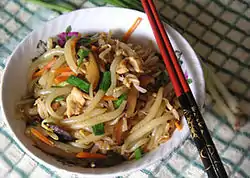 | |
| Alternative names | Rat noodle |
|---|---|
| Type | Chinese noodles |
| Place of origin | China, Meizhou |
| Main ingredients | Rice flour |
| Silver needle noodles | |||||||||||
|---|---|---|---|---|---|---|---|---|---|---|---|
| Chinese name | |||||||||||
| Traditional Chinese | 銀針粉 | ||||||||||
| Simplified Chinese | 银针粉 | ||||||||||
| Literal meaning | silver needle noodle | ||||||||||
| |||||||||||
| Alternative Chinese name | |||||||||||
| Chinese | 老鼠粉 | ||||||||||
| Literal meaning | rat noodle | ||||||||||
| |||||||||||
| Second alternative Chinese name | |||||||||||
| Traditional Chinese | 米篩目 | ||||||||||
| Simplified Chinese | 米筛目 | ||||||||||
| Literal meaning | rice sieve eyes | ||||||||||
| |||||||||||
| Vietnamese name | |||||||||||
| Vietnamese alphabet | bánh lọt mặn | ||||||||||
| Thai name | |||||||||||
| Thai | เกี้ยมอี๋ | ||||||||||
| RTGS | kiam-i | ||||||||||
| Khmer name | |||||||||||
| Khmer | លត | ||||||||||
Silver needle noodle (simplified Chinese: 银针粉; traditional Chinese: 銀針粉; pinyin: yín zhēn fěn), rat noodle (老鼠粉; lǎo shǔ fěn), bee tai bak (simplified Chinese: 米筛目; traditional Chinese: 米篩目; Pe̍h-ōe-jī: bí-thai-ba̍k), runny nose vermicelli (Chinese: 鼻涕嘜; Jyutping: bei6 tai3 mak1) or lot (Khmer: លត), giam ee (เกี้ยมอี๋) is a variety of Chinese noodle.[1] The noodles are short, about 5 cm long and 5 mm in diameter, and white semi-transparent in colour. The noodles are available in many Chinese markets in Chinese populated areas such as Hong Kong, Taiwan, Cambodia, Indonesia, Malaysia , Thailand, Vietnam and Singapore.
Names
Quite a number of names have been used to describe the noodle. The noodle is more commonly known as silver needle noodle in Hong Kong and Taiwan, and rat noodle or "mouse tail noodles" in Malaysia and Singapore. They are sometimes also called as pin noodles.[2] The noodles are named as such because the shape of the noodles is long and tapered much like a rat's tail, translucent white like needles, or from the way the noodles are made by pushing them through the holes of a sieve.
Production
The noodles are made from a mixture of ground rice flour from glutinous or non-glutinous rice and water, but sometimes combined with cornstarch to reduce breakage during cooking.[1] The noodles are made by pushing the rice and water mixture through a sieve directly into boiling water in the same manner as Spätzle.[4] The noodles are made beforehand and then further prepared before serving. The noodles are only available fresh and they are made by noodle vendors or commercially produced and seldom homemade as it is too tedious to make a small amount for home consumption.
Preparation

The noodles may be stir-fried, scalded and flavored with a mixture of sauces, cooked in soup or cooked dry in a clay-pot. As with most Chinese noodles, it can be served for breakfast, lunch or dinner as a main course or supplementing a rice meal. Many Chinese restaurants, hawkers and roadside stalls serve the noodle in various forms. One of the famous dishes that can be found widely in Southeast Asia is Clay-Pot Lao Shu Fen.[5] The purpose of using clay-pot is to keep warmth of the dish.
See also
External links
References
- 1 2 Amy Chen. Short Rice Noodles / Lao Shu Fen 老鼠粉 - MaMaChineseCooking.com or លត lot in Khmer . Accessed January 12, 2007.
- ↑ "pin rice noodles".
- ↑ "All About Noodles, Sen Guay Tiew – Thai Noodles for the Beginner Episode I".
Giam Ee noodles, the rice pin noodles, are rice noodles that have a diameter about 1/4", round, are short, about 2" long, with pointed tips on both ends.
- ↑ 自製手工米苔目, 2009-02-12
- ↑ "seasiafood.com". www.seasiafood.com.